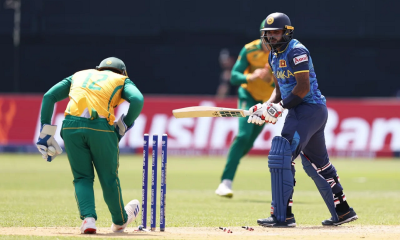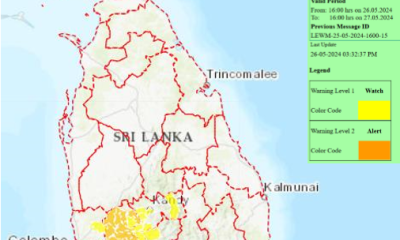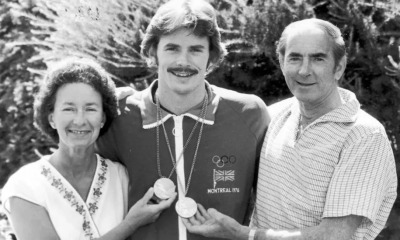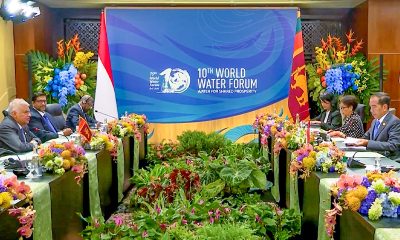Features
The Pharmaceuticals Market in Sri Lanka: Ending the Chaos

By Dr. Dayanath Jayasuriya, President’s Counsel
In 1949 whist debating the Food and Drugs Bill, Dr. N. M. Perera stated, with almost prophetic vision, that “there has been all sorts of muck, if you will permit the use of the word, labeled under the name of drugs in this country.”
More than 70 years later these words are equally true if one were to look at what is available in some places – drugs banned even in the country of origin, expired drugs, drugs in relabeled packages, drugs unregistered with the regulatory authority, drugs of dubious quality, drugs the importation of which specialist committees have cautioned against and drugs from certain manufacturers not known for good quality production facilities.
The list can be much longer. Public sector hospital pharmacies lack even some of the basic essential medicines. In-patients are asked to bring with them cotton wool to surgical equipment if planned surgeries are to take place. Daily qualified specialists as well as young doctors leave the country in search of greener pastures.
From the late 1950s and early 1960s onward Sri Lanka gradually developed a system for the regulation of pharmaceutical products. Initial efforts were due to the singularly impressive work of Professor Senaka Bibile who developed a hospital formulary to rationalize the availability of drugs in the hospitals. Later during his tenure as the founder Chairman of the State Pharmaceuticals Corporation, he found good and relatively inexpensive sources to partially satisfy the country’s demand for imported drugs.
With trade liberalization in 1978, there was an exponential increase in the number and type of medicines that flowed into the country.
In 1980, Sri Lanka enacted the Cosmetics, Devices and Drugs Act. It was based on the Canadian regulatory system. Provisions in the Act and regulations that were enacted five years later provided the basic model of legislation required for developing countries (see, further, D. C. Jayasuriya, Regulation of Pharmaceuticals in Developing Countries: Legal issues and Approaches, WHO, Geneva, 1985). As the country gradually progressed with the expansion of the health-care system, the Act required further amendments but many years later an ill-advised measure was taken to repeal it lock, stock and barrel.
In early 2005 I published a 156 page book entitled Towards a National Drug Policy: Sri Lankan Perspectives. Its nine chapters enumerated measures to be taken based on good practices.
During the drafting of the National Medicines Regulatory Authority Bill, which later became an Act of Parliament (No. 5 of 2015), various groups lobbying to dilute its clauses were very much active. A few professionals posing as independent consultants or experts either lacked expertise in legal drafting or clearly had conflicts of interest. The strongest lobby was for the exclusion of cosmetics from the purview of the legislation, opening the flood gates to import all kinds of products at great cost to the country.
In 2015, a National Medicinal Drug Policy for Sri Lanka was adopted. Its Preamble stated that “Sri Lanka had a partly written Drug policy from the 1960s. It was “written” as elements of a policy, beginning from selection of drugs for the government drug supply and the Ceylon Hospitals formulary in early 1960s, the Bibile-Wickremasinghe report in 1971, the Cosmetics Devices and Drugs Act (1980). However, there was no comprehensive document. There were attempts to develop a NMDP in 1991 & 1996; while the documents were accepted by the Ministry of Health, they did not reach the final step of cabinet approval.” The Policy stated as follows:
A National Standing Committee will be appointed by the Ministry on the recommendation of the Director General of Health Services, comprising all stakeholders to oversee the implementation of the National Medicinal Drug Policy (NMDP).
The Essential Medicines List will prioritize the medicines that are important. The medicines will be selected according to valid scientific evidence, the disease pattern in the country and cost-effectiveness. A standing committee comprising all stakeholders will be established to define and regularly update the National Essential Medicines List. It will formulate, review and update Standard Treatment Guidelines, Drug Index, the Sri Lankan Formulary and Government Drug procurement Documents.
A pricing policy/ mechanism should be adopted to ensure affordability. Retail pricing should be based on a dispensing fee rather than cost markup. Legislation requiring generic prescribing and allowing cost effective generic substitution with the consent of the patient (and where possible informing the doctor) should be enacted.
The state should provide sufficient funding for procurement and supply of necessary medicines with priority for essential medicines, monitor appropriate use and prevent waste. Public and private sector health insurance schemes will be encouraged to develop reimbursable lists of medicines.
The responsibility for ensuring a continuous availability of Essential Medicines in the country is a shared public/private sector responsibility. The state should continue centralized bulk purchase and supply to its institutions. Preference should be given to local manufacturers in supply of medicines to the state sector. Good pharmaceutical procurement practices and management of the supply chain should be enacted for both the public and private sector. There should be a private/public mix of suppliers to the private sector
The regulatory authority should have transparent mechanisms and adequate human resources. Medicines should be registered based on the criteria of quality, safety, efficacy, need and cost effectiveness. An accredited drug quality Assurance Laboratory should function within the authority with appropriate fees for services keeping with WHO Good Clinical Practice Guidelines.
Once the NMDP is adopted, it will be the responsibility of the Minister of Health on the recommendation of the Director General of Health Services, to appoint the National Standing Committee within three months to oversee the implementation of the policy. This policy will be reviewed, and revised if necessary, in five years.
A few months ago guidelines were issued on the tender process for drug procurement. Work on this commenced in 2004 when I was a founder director of the National Procurement Agency set up by the then President HE Chandrika Bandaranaike Kumaratunga.
Quality control problems with a few drugs manufactured in India have been well documented in the past but what is of concern is that still reports appear.
For instance, The Washington Post of April 4, 2023 had an analysis entitled ‘Just How Dangerous Are India’s Generic Drugs?’ The commentator noted: “For a nation that seeks to claim the mantle of “pharmacy to the world,” India is scandalously short on regulatory oversight. In the last six months alone, its generic cough syrups have killed dozens of children, its eye drops have caused blindness and its chemotherapy drugs have been contaminated. The children who died — mostly under the age of five years — were given Indian-made over-the-counter products contaminated with industrial solvents and antifreeze agents that are fatal in even small amounts.
The eye drops contained extensively drug-resistant bacteria. So far 68 patients across 16 US states have been affected. Three people died, several had to have their eyeballs removed, some went blind, the Centers for Disease Control and Prevention reported on March 21. The Indian company issued a voluntary nationwide recall for the drops.
The Wall Street Journal of June 19, 2023 reported that drug shortages stem from quality problems in Indian factories; eye drops, chemotherapy drugs raise concerns about generic products.
Whilst Sri Lankans have to be thankful to India for a generous credit line to import drugs, importation must be done in a structured manner under the oversight of qualified medical specialists.
The priority now is to rapidly compile an inventory of all drugs available in Sri Lanka. Pharmacies must be under a strict legal obligation to provide within a stipulated time-frame material information of the drugs in stock and new drugs on order. Non-compliance must be severely dealt with without fear or favour. Bespoken software is available to systematically enter the data and then to rationalize by an expert committee through a scientific and transparent process what is needed and how gaps need to be met. Otherwise, Sri Lanka will soon become just another junk yard of unwanted and hazardous drugs, negating all the gains from the time of Bibile and other trail-blazers who did their best to ensure that Sri Lanka has one of the best drug regulatory and health-care systems in the developing world.
(The author has advised more than three dozen countries on drug regulatory issues and has published four books and over 50 articles on the subject).
Features
The heart-friendly health minister

by Dr Gotabhya Ranasinghe
Senior Consultant Cardiologist
National Hospital Sri Lanka
When we sought a meeting with Hon Dr. Ramesh Pathirana, Minister of Health, he graciously cleared his busy schedule to accommodate us. Renowned for his attentive listening and deep understanding, Minister Pathirana is dedicated to advancing the health sector. His openness and transparency exemplify the qualities of an exemplary politician and minister.
Dr. Palitha Mahipala, the current Health Secretary, demonstrates both commendable enthusiasm and unwavering support. This combination of attributes makes him a highly compatible colleague for the esteemed Minister of Health.
Our discussion centered on a project that has been in the works for the past 30 years, one that no other minister had managed to advance.
Minister Pathirana, however, recognized the project’s significance and its potential to revolutionize care for heart patients.
The project involves the construction of a state-of-the-art facility at the premises of the National Hospital Colombo. The project’s location within the premises of the National Hospital underscores its importance and relevance to the healthcare infrastructure of the nation.
This facility will include a cardiology building and a tertiary care center, equipped with the latest technology to handle and treat all types of heart-related conditions and surgeries.
Securing funding was a major milestone for this initiative. Minister Pathirana successfully obtained approval for a $40 billion loan from the Asian Development Bank. With the funding in place, the foundation stone is scheduled to be laid in September this year, and construction will begin in January 2025.
This project guarantees a consistent and uninterrupted supply of stents and related medications for heart patients. As a result, patients will have timely access to essential medical supplies during their treatment and recovery. By securing these critical resources, the project aims to enhance patient outcomes, minimize treatment delays, and maintain the highest standards of cardiac care.
Upon its fruition, this monumental building will serve as a beacon of hope and healing, symbolizing the unwavering dedication to improving patient outcomes and fostering a healthier society.We anticipate a future marked by significant progress and positive outcomes in Sri Lanka’s cardiovascular treatment landscape within the foreseeable timeframe.
Features
A LOVING TRIBUTE TO JESUIT FR. ALOYSIUS PIERIS ON HIS 90th BIRTHDAY

by Fr. Emmanuel Fernando, OMI
Jesuit Fr. Aloysius Pieris (affectionately called Fr. Aloy) celebrated his 90th birthday on April 9, 2024 and I, as the editor of our Oblate Journal, THE MISSIONARY OBLATE had gone to press by that time. Immediately I decided to publish an article, appreciating the untiring selfless services he continues to offer for inter-Faith dialogue, the renewal of the Catholic Church, his concern for the poor and the suffering Sri Lankan masses and to me, the present writer.
It was in 1988, when I was appointed Director of the Oblate Scholastics at Ampitiya by the then Oblate Provincial Fr. Anselm Silva, that I came to know Fr. Aloy more closely. Knowing well his expertise in matters spiritual, theological, Indological and pastoral, and with the collaborative spirit of my companion-formators, our Oblate Scholastics were sent to Tulana, the Research and Encounter Centre, Kelaniya, of which he is the Founder-Director, for ‘exposure-programmes’ on matters spiritual, biblical, theological and pastoral. Some of these dimensions according to my view and that of my companion-formators, were not available at the National Seminary, Ampitiya.
Ever since that time, our Oblate formators/ accompaniers at the Oblate Scholasticate, Ampitiya , have continued to send our Oblate Scholastics to Tulana Centre for deepening their insights and convictions regarding matters needed to serve the people in today’s context. Fr. Aloy also had tried very enthusiastically with the Oblate team headed by Frs. Oswald Firth and Clement Waidyasekara to begin a Theologate, directed by the Religious Congregations in Sri Lanka, for the contextual formation/ accompaniment of their members. It should very well be a desired goal of the Leaders / Provincials of the Religious Congregations.
Besides being a formator/accompanier at the Oblate Scholasticate, I was entrusted also with the task of editing and publishing our Oblate journal, ‘The Missionary Oblate’. To maintain the quality of the journal I continue to depend on Fr. Aloy for his thought-provoking and stimulating articles on Biblical Spirituality, Biblical Theology and Ecclesiology. I am very grateful to him for his generous assistance. Of late, his writings on renewal of the Church, initiated by Pope St. John XX111 and continued by Pope Francis through the Synodal path, published in our Oblate journal, enable our readers to focus their attention also on the needed renewal in the Catholic Church in Sri Lanka. Fr. Aloy appreciated very much the Synodal path adopted by the Jesuit Pope Francis for the renewal of the Church, rooted very much on prayerful discernment. In my Religious and presbyteral life, Fr.Aloy continues to be my spiritual animator / guide and ongoing formator / acccompanier.
Fr. Aloysius Pieris, BA Hons (Lond), LPh (SHC, India), STL (PFT, Naples), PhD (SLU/VC), ThD (Tilburg), D.Ltt (KU), has been one of the eminent Asian theologians well recognized internationally and one who has lectured and held visiting chairs in many universities both in the West and in the East. Many members of Religious Congregations from Asian countries have benefited from his lectures and guidance in the East Asian Pastoral Institute (EAPI) in Manila, Philippines. He had been a Theologian consulted by the Federation of Asian Bishops’ Conferences for many years. During his professorship at the Gregorian University in Rome, he was called to be a member of a special group of advisers on other religions consulted by Pope Paul VI.
Fr. Aloy is the author of more than 30 books and well over 500 Research Papers. Some of his books and articles have been translated and published in several countries. Among those books, one can find the following: 1) The Genesis of an Asian Theology of Liberation (An Autobiographical Excursus on the Art of Theologising in Asia, 2) An Asian Theology of Liberation, 3) Providential Timeliness of Vatican 11 (a long-overdue halt to a scandalous millennium, 4) Give Vatican 11 a chance, 5) Leadership in the Church, 6) Relishing our faith in working for justice (Themes for study and discussion), 7) A Message meant mainly, not exclusively for Jesuits (Background information necessary for helping Francis renew the Church), 8) Lent in Lanka (Reflections and Resolutions, 9) Love meets wisdom (A Christian Experience of Buddhism, 10) Fire and Water 11) God’s Reign for God’s poor, 12) Our Unhiddden Agenda (How we Jesuits work, pray and form our men). He is also the Editor of two journals, Vagdevi, Journal of Religious Reflection and Dialogue, New Series.
Fr. Aloy has a BA in Pali and Sanskrit from the University of London and a Ph.D in Buddhist Philosophy from the University of Sri Lankan, Vidyodaya Campus. On Nov. 23, 2019, he was awarded the prestigious honorary Doctorate of Literature (D.Litt) by the Chancellor of the University of Kelaniya, the Most Venerable Welamitiyawe Dharmakirthi Sri Kusala Dhamma Thera.
Fr. Aloy continues to be a promoter of Gospel values and virtues. Justice as a constitutive dimension of love and social concern for the downtrodden masses are very much noted in his life and work. He had very much appreciated the commitment of the late Fr. Joseph (Joe) Fernando, the National Director of the Social and Economic Centre (SEDEC) for the poor.
In Sri Lanka, a few religious Congregations – the Good Shepherd Sisters, the Christian Brothers, the Marist Brothers and the Oblates – have invited him to animate their members especially during their Provincial Congresses, Chapters and International Conferences. The mainline Christian Churches also have sought his advice and followed his seminars. I, for one, regret very much, that the Sri Lankan authorities of the Catholic Church –today’s Hierarchy—- have not sought Fr.
Aloy’s expertise for the renewal of the Catholic Church in Sri Lanka and thus have not benefited from the immense store of wisdom and insight that he can offer to our local Church while the Sri Lankan bishops who governed the Catholic church in the immediate aftermath of the Second Vatican Council (Edmund Fernando OMI, Anthony de Saram, Leo Nanayakkara OSB, Frank Marcus Fernando, Paul Perera,) visited him and consulted him on many matters. Among the Tamil Bishops, Bishop Rayappu Joseph was keeping close contact with him and Bishop J. Deogupillai hosted him and his team visiting him after the horrible Black July massacre of Tamils.
Features
A fairy tale, success or debacle

Sri Lanka-Singapore Free Trade Agreement
By Gomi Senadhira
senadhiragomi@gmail.com
“You might tell fairy tales, but the progress of a country cannot be achieved through such narratives. A country cannot be developed by making false promises. The country moved backward because of the electoral promises made by political parties throughout time. We have witnessed that the ultimate result of this is the country becoming bankrupt. Unfortunately, many segments of the population have not come to realize this yet.” – President Ranil Wickremesinghe, 2024 Budget speech
Any Sri Lankan would agree with the above words of President Wickremesinghe on the false promises our politicians and officials make and the fairy tales they narrate which bankrupted this country. So, to understand this, let’s look at one such fairy tale with lots of false promises; Ranil Wickremesinghe’s greatest achievement in the area of international trade and investment promotion during the Yahapalana period, Sri Lanka-Singapore Free Trade Agreement (SLSFTA).
It is appropriate and timely to do it now as Finance Minister Wickremesinghe has just presented to parliament a bill on the National Policy on Economic Transformation which includes the establishment of an Office for International Trade and the Sri Lanka Institute of Economics and International Trade.
Was SLSFTA a “Cleverly negotiated Free Trade Agreement” as stated by the (former) Minister of Development Strategies and International Trade Malik Samarawickrama during the Parliamentary Debate on the SLSFTA in July 2018, or a colossal blunder covered up with lies, false promises, and fairy tales? After SLSFTA was signed there were a number of fairy tales published on this agreement by the Ministry of Development Strategies and International, Institute of Policy Studies, and others.
However, for this article, I would like to limit my comments to the speech by Minister Samarawickrama during the Parliamentary Debate, and the two most important areas in the agreement which were covered up with lies, fairy tales, and false promises, namely: revenue loss for Sri Lanka and Investment from Singapore. On the other important area, “Waste products dumping” I do not want to comment here as I have written extensively on the issue.
1. The revenue loss
During the Parliamentary Debate in July 2018, Minister Samarawickrama stated “…. let me reiterate that this FTA with Singapore has been very cleverly negotiated by us…. The liberalisation programme under this FTA has been carefully designed to have the least impact on domestic industry and revenue collection. We have included all revenue sensitive items in the negative list of items which will not be subject to removal of tariff. Therefore, 97.8% revenue from Customs duty is protected. Our tariff liberalisation will take place over a period of 12-15 years! In fact, the revenue earned through tariffs on goods imported from Singapore last year was Rs. 35 billion.
The revenue loss for over the next 15 years due to the FTA is only Rs. 733 million– which when annualised, on average, is just Rs. 51 million. That is just 0.14% per year! So anyone who claims the Singapore FTA causes revenue loss to the Government cannot do basic arithmetic! Mr. Speaker, in conclusion, I call on my fellow members of this House – don’t mislead the public with baseless criticism that is not grounded in facts. Don’t look at petty politics and use these issues for your own political survival.”
I was surprised to read the minister’s speech because an article published in January 2018 in “The Straits Times“, based on information released by the Singaporean Negotiators stated, “…. With the FTA, tariff savings for Singapore exports are estimated to hit $10 million annually“.
As the annual tariff savings (that is the revenue loss for Sri Lanka) calculated by the Singaporean Negotiators, Singaporean $ 10 million (Sri Lankan rupees 1,200 million in 2018) was way above the rupees’ 733 million revenue loss for 15 years estimated by the Sri Lankan negotiators, it was clear to any observer that one of the parties to the agreement had not done the basic arithmetic!
Six years later, according to a report published by “The Morning” newspaper, speaking at the Committee on Public Finance (COPF) on 7th May 2024, Mr Samarawickrama’s chief trade negotiator K.J. Weerasinghehad had admitted “…. that forecasted revenue loss for the Government of Sri Lanka through the Singapore FTA is Rs. 450 million in 2023 and Rs. 1.3 billion in 2024.”
If these numbers are correct, as tariff liberalisation under the SLSFTA has just started, we will pass Rs 2 billion very soon. Then, the question is how Sri Lanka’s trade negotiators made such a colossal blunder. Didn’t they do their basic arithmetic? If they didn’t know how to do basic arithmetic they should have at least done their basic readings. For example, the headline of the article published in The Straits Times in January 2018 was “Singapore, Sri Lanka sign FTA, annual savings of $10m expected”.
Anyway, as Sri Lanka’s chief negotiator reiterated at the COPF meeting that “…. since 99% of the tariffs in Singapore have zero rates of duty, Sri Lanka has agreed on 80% tariff liberalisation over a period of 15 years while expecting Singapore investments to address the imbalance in trade,” let’s turn towards investment.
Investment from Singapore
In July 2018, speaking during the Parliamentary Debate on the FTA this is what Minister Malik Samarawickrama stated on investment from Singapore, “Already, thanks to this FTA, in just the past two-and-a-half months since the agreement came into effect we have received a proposal from Singapore for investment amounting to $ 14.8 billion in an oil refinery for export of petroleum products. In addition, we have proposals for a steel manufacturing plant for exports ($ 1 billion investment), flour milling plant ($ 50 million), sugar refinery ($ 200 million). This adds up to more than $ 16.05 billion in the pipeline on these projects alone.
And all of these projects will create thousands of more jobs for our people. In principle approval has already been granted by the BOI and the investors are awaiting the release of land the environmental approvals to commence the project.
I request the Opposition and those with vested interests to change their narrow-minded thinking and join us to develop our country. We must always look at what is best for the whole community, not just the few who may oppose. We owe it to our people to courageously take decisions that will change their lives for the better.”
According to the media report I quoted earlier, speaking at the Committee on Public Finance (COPF) Chief Negotiator Weerasinghe has admitted that Sri Lanka was not happy with overall Singapore investments that have come in the past few years in return for the trade liberalisation under the Singapore-Sri Lanka Free Trade Agreement. He has added that between 2021 and 2023 the total investment from Singapore had been around $162 million!
What happened to those projects worth $16 billion negotiated, thanks to the SLSFTA, in just the two-and-a-half months after the agreement came into effect and approved by the BOI? I do not know about the steel manufacturing plant for exports ($ 1 billion investment), flour milling plant ($ 50 million) and sugar refinery ($ 200 million).
However, story of the multibillion-dollar investment in the Petroleum Refinery unfolded in a manner that would qualify it as the best fairy tale with false promises presented by our politicians and the officials, prior to 2019 elections.
Though many Sri Lankans got to know, through the media which repeatedly highlighted a plethora of issues surrounding the project and the questionable credentials of the Singaporean investor, the construction work on the Mirrijiwela Oil Refinery along with the cement factory began on the24th of March 2019 with a bang and Minister Ranil Wickremesinghe and his ministers along with the foreign and local dignitaries laid the foundation stones.
That was few months before the 2019 Presidential elections. Inaugurating the construction work Prime Minister Ranil Wickremesinghe said the projects will create thousands of job opportunities in the area and surrounding districts.
The oil refinery, which was to be built over 200 acres of land, with the capacity to refine 200,000 barrels of crude oil per day, was to generate US$7 billion of exports and create 1,500 direct and 3,000 indirect jobs. The construction of the refinery was to be completed in 44 months. Four years later, in August 2023 the Cabinet of Ministers approved the proposal presented by President Ranil Wickremesinghe to cancel the agreement with the investors of the refinery as the project has not been implemented! Can they explain to the country how much money was wasted to produce that fairy tale?
It is obvious that the President, ministers, and officials had made huge blunders and had deliberately misled the public and the parliament on the revenue loss and potential investment from SLSFTA with fairy tales and false promises.
As the president himself said, a country cannot be developed by making false promises or with fairy tales and these false promises and fairy tales had bankrupted the country. “Unfortunately, many segments of the population have not come to realize this yet”.
(The writer, a specialist and an activist on trade and development issues . )
























